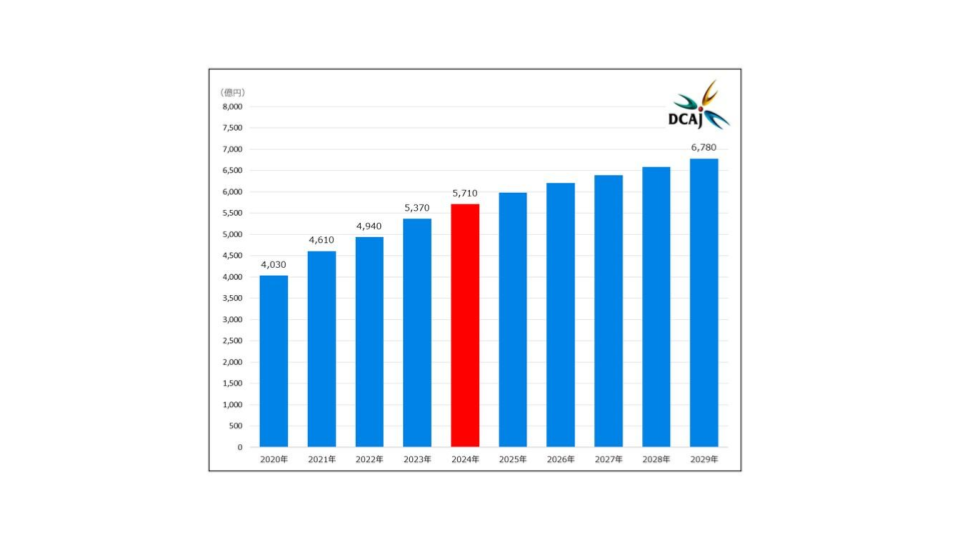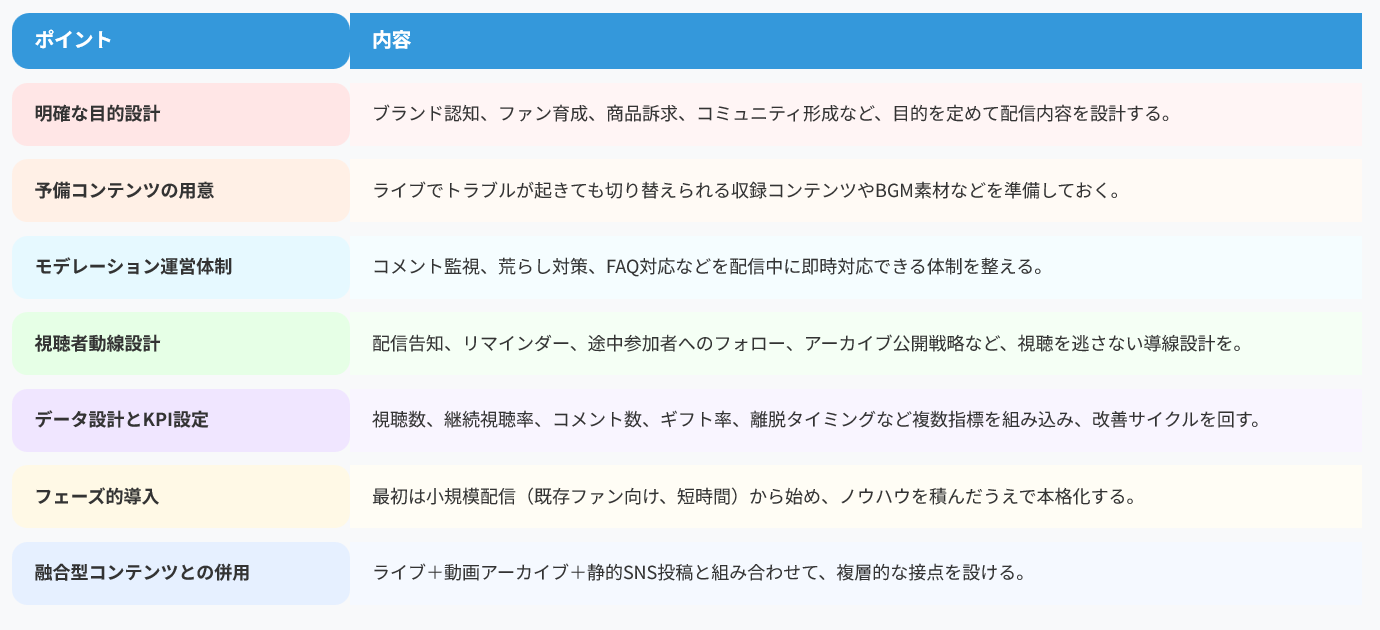With deep expertise in the Japanese market and global trends, we empower brands to expand internationally. Bridging cultures, languages, and markets through strategic digital marketing, cross-cultural communication, and authentic brand storytelling.


sns-column
How to use live streaming in social media marketing?

Table of Contents [Click to view]
Advantages, disadvantages, and key points for implementation that companies should know
Why live streaming is gaining attention
Benefits: Strong engagement through interactivity and immersion
- Creating a sense of co-creation through audience participation communication
- High viewing rates/frequency of use and the development of viewing habits
- Differentiation/Brand Story Promotion
- Immediate feedback and improvement cycle for measures
Disadvantages: Risk and operational burden, uncertainty of viewership motivation
- Large workload for distribution preparation and management
- The uncertainty of whether viewers will "attend"
- Risk of flame wars and real-time responses
- Difficulty in measurement and effectiveness evaluation
Key points for businesses to consider when introducing live streaming
Future outlook for the live streaming market
Advantages, disadvantages, and key points for implementation that companies should know
Why live streaming is gaining attention
The video and live streaming market has continued to expand in recent years. For example, the Digital Content Association of Japan (DCAJ) estimates that the video streaming market (including VOD) will be worth 571 billion yen in 2024 (up 6% from the previous year), and is expected to grow to 678 billion yen by 2029.
Additionally, according to a survey by Yano Research Institute, the live streaming app market is estimated to reach 72 billion yen in 2023, an increase of 112.5% from the previous year, indicating a strong expansion trend.
Furthermore, MRFR's analysis estimates that Japan's live streaming market (including live broadcasts) will be worth approximately USD 201 million (equivalent to just over JPY 30 billion) in 2023, and is forecast to grow to USD 252 million in 2024 and USD 3.105 billion in 2035 (average annual growth rate: 25.65%).

Source: PR TIMES "About the Publication of the 'Video Streaming Market Research Report 2025'" https://prtimes.jp/main/html/rd/p/000000065.000037875.html
As such, while video and live streaming are already showing signs of maturing, they are attracting attention as an area where they can differentiate themselves through real-time and interactivity. In particular, real-time streaming using VTubers and VR is beginning to be used as a means to strengthen fan engagement, starting with "real-time two-way communication" with viewers.
In this blog, we will summarize the advantages and disadvantages of live streaming when companies adopt it as part of their social media operations or digital initiatives, and introduce key points to consider when using it.
Benefits: Strong engagement through interactivity and immersion
-
1. Creating a sense of co-creation through audience participation communication
Unlike the traditional one-way transmission of the four mass media, live streaming using VTubers and VR allows viewers to interact in real time with the content, such as comments, votes, reactions, and gifts. This allows viewers to participate in the experience rather than simply watch, making it easier for them to make it their own. This sense of co-creation strengthens fan loyalty and makes it easier to foster understanding and empathy for the brand.
-
2. High viewing rates/frequency of use and the development of viewing habits
Live streaming also has the potential to make viewing a habit.
According to a "Live Streaming Survey" conducted by Mache Lab, an owned media outlet operated by Machebara Talk Inc., which surveyed 492 men and women aged 15 to 59 from across Japan about the viewing habits and values of live streaming, 72.4% of the total respondents have watched live streaming, with 44.3% of men and 36.4% of women watching at least once a week. In this way, live streaming has already become a "media that can be viewed regularly," and there is room for companies to use it as a continuous communication base.
-
3. Differentiation/Brand Story Promotion
Amidst the flood of video content, live streaming offers added value in the form of a "real-time" and "presence" feel. It can be differentiated from static videos and still image posts, and is an effective means of "communicating a brand's worldview and message in real time." Furthermore, streaming through VR spaces or virtual characters allows for expression that transcends physical constraints.
-
4. Immediate feedback and improvement cycle for measures
Live streaming allows you to obtain metrics such as the number of viewers, comments, and dropout rates in real time. This allows you to instantly understand which segments are dropping out, which topics are getting a good response, and so on, speeding up the cycle of making improvements for the next time. Another attractive feature is the flexibility to "optimize on the spot," such as taking surveys midway through or changing the topic based on viewer reactions.
Disadvantages: Risk and operational burden, uncertainty of viewership motivation
-
1. Large workload for distribution preparation and management
Because live streaming is "real-time," troubleshooting and operational skills are essential. Advance preparation and on-the-day operational know-how are essential for dealing with audio and video glitches, line outages, delayed comments, and delays in the performers' progress. When using VTubers and VR spaces, technical aspects such as avatar motion control, scene direction, synchronization delay countermeasures, and direction switching also become important, making it necessary to establish a collaborative system between the production, direction, and technical teams.
-
2. The uncertainty of whether viewers will "attend"
Unlike on-demand videos, live streaming poses the hurdle of "getting people to come at that time." If viewers aren't motivated to make time for it, it can be difficult to get an audience for a live event. Data also shows that the domestic market for paid online live events shrank to 29.5 billion yen in 2023, a 36.7% decrease from the previous year, as a reaction to the COVID-19 pandemic. In other words, live events don't guarantee viewership; audience-attraction strategies and appeal are important.
-
3. Risk of flame wars and real-time responses
In live streaming, comments are reflected instantly, and viewers' reactions are returned directly. However, there is a high risk of causing outrage or misunderstanding due to poor word choice or management response, so careful governance is required regarding comments and presentation. It is also essential to have a moderation system in place to deal with extreme comments from viewers, trolling, slander, and other abuse.
-
4. Difficulty in measurement and effectiveness evaluation
Unlike on-demand videos, it can be difficult to grasp the "quality of the viewing experience" simply by looking at the number of views. A design that captures the flow of viewers, such as whether they "only watched the first part and then left," or "watched until the end and made a big reaction (comments or gifts)," is necessary. Furthermore, live viewership ratings cannot be measured using the same methods as TV viewership ratings, and an analysis design based on online meters and logs is required.
One way to measure this is to set up a special website or landing page for the products introduced in the video, which will allow you to measure sales and number of conversions.
Key points for businesses to consider when introducing live streaming
Now that the advantages and disadvantages have been clarified, we have summarized the key points to consider when actually introducing live streaming as a company.

Future outlook for the live streaming market
Live streaming is a method that starts with "on-the-spot communication" and shortens the distance with viewers, making it easy to cultivate fans and create brand empathy. Utilizing live streamers, it has the advantage of being an "experiential information dissemination" that turns viewers into participants.
However, the operational burden, risk of outrage, and difficulty in guiding viewers to watch cannot be ignored due to the real-time nature of the service. Therefore, when a company uses it, it is important to first clarify its purpose and gradually build up know-how.
If you can think of live streaming and SNS management as a "combined strategy" and design a balanced mix of video, live broadcasts, and static posts, you may be able to build strong digital connections in the long term.
If you are considering a new promotional method, please give it a try.
Our Clients for creative work




















Recruitment Information
We are looking for members who can help each other improve and create new things in a fast-paced environment.
Inquiry
If you have any questions or concerns about our services, please feel free to contact us.

